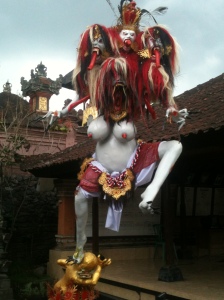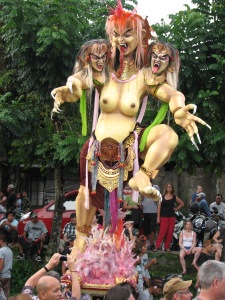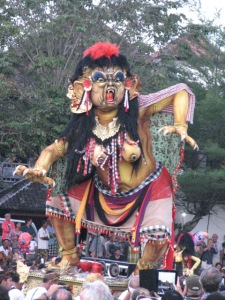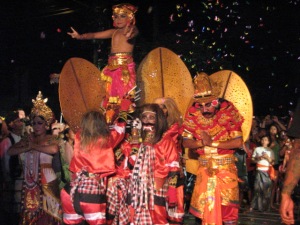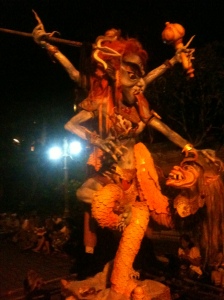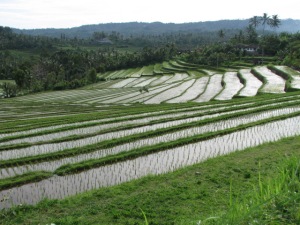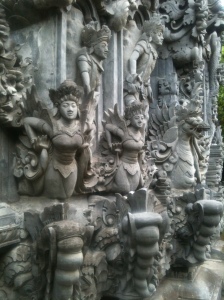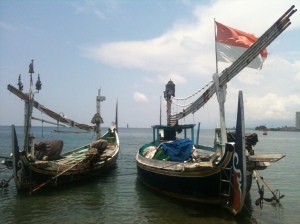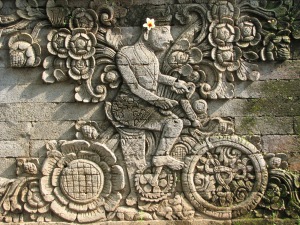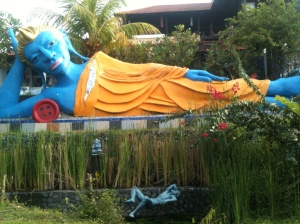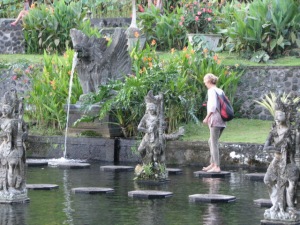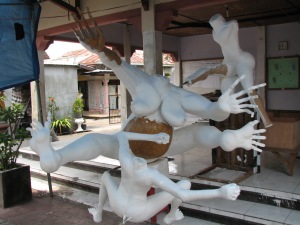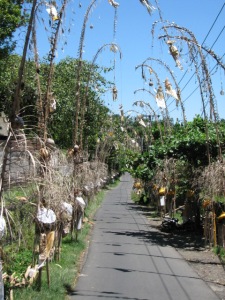Soon after we arrived here almost a year ago, we began to notice large, colorful, and scary figures off to the side of the roads. They were well made, and stood on small bases, often with one leg raised and arms outstretched and faces contorted in anger, as if attacking something. Sometimes they had 3 heads, or 6 arms, or snakes growing out of their chest. And sometimes their anatomicals were included -and greatly exaggerated. It took a while to understand that they were holdovers from an annual event held every March, called Nyepi. It’s a Hindu celebration, virtually exclusive to the island of Bali, and commemorates the new year of the Balinese calendar. The exact day in March can vary wildly from year to year, characteristic of the highly complex Balinese saka calendar. This year Nyepi fell on March 31st.
Starting in January, we began to see those large characters being build throughout the villages, always by groups of young men. We were impressed by their accurate representations, often started with simple wood pieces, wrapped with reeds in such a manner as to properly describe the muscles and bones, before being covered with paper-mache, or foam. These statues are called Ogoh-Ogoh, and usually represent specific forms of mythological demons inspired by Hindu philosophy. Their main purpose is to purify the natural environment of man-made spiritual pollutants. Surprisingly, they are a fairly recent addition to the Nyepi tradition, dating to the early 1980’s. Back then, they were carefully monitored for any criticism of the Suharto regime.
During our March road trip around Bali, we noticed how the entire island was getting dressed up for Nyepi. Tall bamboo poles lined the streets, arching over the roads, dangling delicate reed ornaments overhead. There was a buzz in the air, and an escalation of firework-like explosions, shot out of bamboo tubes carried by young men. We returned from our trip just 2 days before the first Nyepi related ceremony began, called the Melasi Ritual. This involves ceremonies that take place at temples near the coast, and end with a march to the sea to acquire sacred water. We missed this ritual, but were told that it was quite moving and is not to be missed next year.
The next event was the parade and subsequent burning of (most of) the Ogoh-Ogoh’s. Jennifer and I enjoyed riding around to the different villages in and around Ubud during the last days to look at them. By now, each character was affixed upon a wide matrix of bamboo poles so that the group of boys who built each one could pick it up, spin it around, and take it away as needed. When we found 1 Ogoh-Ogoh, we usually found several more, brought together for all to admire. Their creators sat proudly nearby, eagerly waiting for the festivities to begin. Parents and small children rode up on motorbikes to admire and take photos, and then headed off in search of the next cluster.
Finally, the day came. Every village hosted a celebration. We were torn between wanting to stay in our own, smaller village of Penestanan, versus watching the larger event in the heart of Ubud. We chose the later, and by late afternoon entered onto the corner soccer field on Monkey Forest road. Many diverse statues were on display, and many more were still coming in, carried by 25-100 exuberant young men -depending on the size of their creation. As dusk settled in, they were systematically carried away, to the main Ubud intersection, in front of the Ubud Palace. Men and women marched alongside, carrying lit torches. Traditional musical bands of excited young men joined the stream too, adding that magical and integral element to Balinese ceremony.
In an effort to escape the growing crowd, we ended up instead trapped inside a cul-de-sac of packed onlookers. Turns out it was the perfect space to watch the dazzling costumed dancers and large shadow-puppet shows that we didn’t know would happen. We did feel fortunate to watch it, but it was a tight squeeze, and a little hairy at times. The individual floats arrived one at a time, and were frantically spun around 3 times in a circle as a means to shake and confuse the demons. The packed, encroaching crowd needed to react fast and sway accordingly, and at some point, it felt unsafe and not as fun. But we’d seen the bulk of it all by then, and wondered how it was going back in our own village. We eventually found a circuitous path through and away from the sardine crowd and back to our motorbike, and headed the long way around, through the actual monkey forest -which is a little spooky at night. But then we were blocked from getting home by all the other village ceremonies. Each attempt to outsmart the gridlock led to more impenetrable festivals. This was both frustrating and fun, and presented some interesting glimpses of these villages, and a long, sweet encounter with an older Balinese woman who treated us like her long-lost children. Eventually Jen remembered a tricky, narrow, dark, gravel shortcut back through the haunted monkey forest that did the trick and got us home. But by then, the festivities in our village and most elsewhere were over, so we went home and prepared for the most important part of Nyepi.
The ‘Day of Silence” starts with the following sunrise (6:00) and ends 24 hours later. It is declared as a day without noise, work, play, fire, electricity, or travelling. The airport is shut down, all businesses are closed, and everyone other than the police are instructed to stay indoors. All the streets are empty, all across the island. The idea is to fool the evil spirits into thinking that the island is uninhabited, so as to leave it alone, and the Balinese take this effort very seriously. It is a period reserved for introspection and meditation, and many people fast -though we did not. The stars were especially bright due to the lack of light everywhere. And even the dogs, frogs and insects -which usually sound like an orchestra every night- seemed aware and respectful of the occasion and remained quiet. Really.
We enjoyed this 24-hour house arrest. It was the quietest day of my life. I couldn’t help but note the contrast between it and the March 31st of last year, which was perhaps the busiest day of my life, and the end to the busiest month I’ve ever known. We needed to be out of our SF house by that day’s end, with all details and loose ends addressed. That was our last night in Bernal Heights.
The day after the Day of Silence is New Year’s day, and most places remain closed. Traditionally, the Balinese use this day to seek and offer forgiveness with one another. It’s now 1936 in the Balinese calendar. Selamat baik ulang tahun!
-matt





